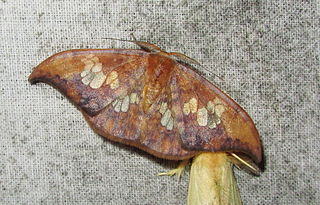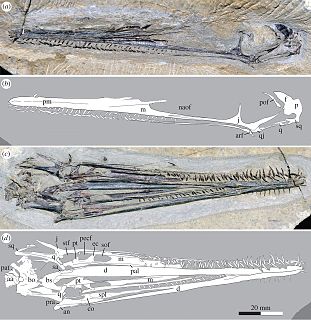
Nicrosaurus (/nɛkroʊˈsɔrəs/) is an extinct genus of phytosaur reptile existing during the Late Triassic period. Although it looked like a crocodile, it was not closely related to these creatures, instead being an example of parallel evolution. The main difference between Nicrosaurus and modern crocodiles is the position of the nostrils – Nicrosaurus's nostrils, or external nares, were placed directly in front of the forehead, whereas in crocodiles, the nostrils are positioned on the end of the snout. A 2013 study has also found that illium of Nicrosaurus is quite distinctive from all other phytosaurs.

Megalancosaurus is a genus of extinct reptile from the Late Triassic Dolomia di Forni Formation and Zorzino Limestone of northern Italy, and one of the best known drepanosaurids. The type species is M. preonensis; a translation of the animal's scientific name would be "long armed reptile from the Preone Valley."
Stegotretus is an extinct genus of lepospondyl microsaur referred to the Pantylidae. It is known from the Carboniferous–Permian boundary Cutler Formation exposures of New Mexico.

Agnidra is a genus of moths belonging to the subfamily Drepaninae.
Unwindia is a genus of pterodactyloid pterosaur from the Early Cretaceous of Brazil.
Polypoetes bifenestra is a moth of the family Notodontidae. It is found in cloud forests in the Oriente of northern Ecuador at elevations between 2,000 and 3,000 meters.
Agnidra fulvior is a moth in the family Drepanidae. It was described by Watson in 1968. It is found in China (Yunnan).
Agnidra furva is a moth in the family Drepanidae. It was described by Watson in 1968. It is found in China (Yunnan).
Agnidra hoenei is a moth in the family Drepanidae. It was described by Watson in 1968. It is found in China (Yunnan).

Agnidra fuscilinea is a moth in the family Drepanidae. It was described by Watson in 1961. It is found on Peninsular Malaysia, Sumatra and Borneo.
Agnidra ataxia is a moth in the family Drepanidae. It was described by Hong-Fu Chu and Lin-Yao Wang in 1988. It is found in Yunnan, China.
Agnidra argypha is a moth in the family Drepanidae. It was described by Hong-Fu Chu and Lin-Yao Wang in 1988. It is found in Yunnan, China.
Agnidra tanyospinosa is a moth in the family Drepanidae. It was described by Hong-Fu Chu and Lin-Yao Wang in 1988. It is found in Guangdong, China.
Agnidra tigrina is a moth in the family Drepanidae. It was described by Hong-Fu Chu and Lin-Yao Wang in 1988. It is found in Yunnan, China.

Agnidra specularia is a moth in the family Drepanidae. It was described by Francis Walker in 1860. It is found in Sri Lanka, north-eastern India, Bhutan, Vietnam and Xizang, China.
Agnidra corticata is a moth in the family Drepanidae. It was described by Warren in 1922. It is found in north-eastern India and China (Sichuan).

Agnidra vinacea is a moth in the family Drepanidae. It was described by Frederic Moore in 1879. It is found in Sikkim, north-eastern India and north-eastern Myanmar.

Agnidra discispilaria is a moth in the family Drepanidae. It was described by Moore in 1867. It is found in north-eastern India, Sikkim and Thailand.
Agnidra scabiosa is a moth in the family Drepanidae. It was described by Arthur Gardiner Butler in 1877. It is found in south-eastern Russia, Korea, Japan and China.

Liaodactylus is a genus of filter-feeding ctenochasmatid pterosaur from the Jurassic of China. The genus contains one species, L. primus, described by Zhou et al. in 2017. As an adaptation to filter-feeding, Liaodactylus had approximately 150 long, comb-like teeth packed closely together. It is both the earliest known ctenochasmatid and the first filter-feeding pterosaur from the Jurassic Tiaojishan Formation. Later and more specialized ctenochasmatids differ from Liaodactylus in having longer snouts, smaller openings in the skull, and more teeth. Within the Ctenochasmatidae, Liaodactylus was most closely related to the European Ctenochasma.






